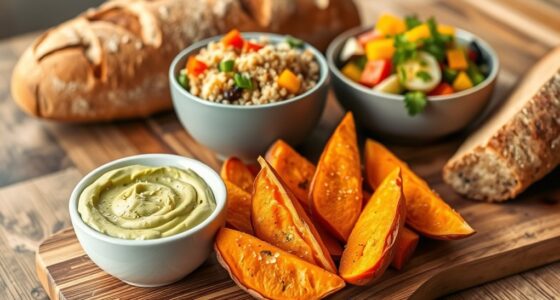High-protein meals are essential for GLP-1 users because they help stabilize blood sugar and keep you feeling full longer. By incorporating lean proteins like chicken, turkey, fish, and plant-based options such as quinoa and tofu, you can manage cravings and maintain steady energy levels. Starting your day with a protein-packed breakfast and distributing meals throughout the day can enhance your appetite control. Plus, there are great snack options that can support your health goals too. Want to know more?
Key Takeaways
- High-protein meals stabilize blood sugar, crucial for GLP-1 users in managing their condition effectively.
- Incorporate lean proteins like chicken, turkey, fish, and plant-based options such as lentils and tofu.
- Distribute protein intake throughout the day to prevent blood sugar spikes and maintain energy levels.
- Snack on high-protein options like Greek yogurt, cottage cheese, and almonds to curb hunger and resist cravings.
- Plan and prepare meals in advance, focusing on nutrient-dense, filling options to support weight management goals.

If you’re using GLP-1 medications to manage your weight or blood sugar, incorporating high-protein meals into your diet can be a game changer. Protein plays a vital role in your health, especially when you’re aiming to stabilize blood sugar levels and control appetite. By choosing high-protein options, you can feel fuller longer, which helps you resist cravings and maintain a steady energy level throughout the day.
Incorporating high-protein meals can transform your weight management and blood sugar control while using GLP-1 medications.
When planning your meals, focus on lean protein sources. Chicken, turkey, fish, eggs, and legumes are excellent choices. Not only are they low in fat, but they also provide essential nutrients. For instance, fish like salmon or mackerel offer omega-3 fatty acids, which are beneficial for heart health. You might also want to experiment with plant-based proteins such as quinoa, lentils, or tofu. These options pack a punch in terms of nourishment while being versatile for various recipes.
Don’t forget about the importance of meal timing. Eating high-protein meals spreads throughout the day can help you avoid blood sugar spikes. You could start your day with a protein-rich breakfast, like scrambled eggs with spinach and feta. This sets a positive tone for your eating habits. For lunch, consider a grilled chicken salad loaded with colorful veggies and a protein-packed dressing like hummus. You’ll find that these meals not only satisfy your hunger but also keep your energy levels steady.
Snack time can be a challenge, especially when you’re trying to keep your appetite in check. Instead of reaching for sugary snacks, opt for high-protein options like Greek yogurt, cottage cheese, or a handful of almonds. These choices will help curb your appetite and provide a boost of energy without sending your blood sugar on a rollercoaster ride.
When you’re planning dinner, think about incorporating a variety of proteins into your meals. You might try a stir-fry with tofu and mixed vegetables or a hearty chili loaded with beans and lean ground turkey. These meals are not just filling; they can also be prepared in batches, making it easier to stick to your high-protein plan throughout the week.
Incorporating high-protein meals into your diet while using GLP-1 medications can truly support your health goals. By staying mindful of your protein intake and making smart choices, you’re setting yourself up for long-term success in weight management and blood sugar control. Additionally, the use of Intelligent Tutoring Systems can provide personalized meal planning assistance to help you stay on track with your dietary goals.
Frequently Asked Questions
Can I Use Plant-Based Proteins for GLP-1 Diets?
Yes, you can definitely use plant-based proteins for your GLP-1 diet. Foods like lentils, chickpeas, quinoa, and tofu provide excellent protein sources while being rich in fiber. They help keep you feeling full and satisfied, which is important for managing appetite. Just make sure to balance your meals with other nutrients and monitor how your body responds. Experiment with different plant-based options to find what works best for you!
How Do High-Protein Meals Affect Blood Sugar Levels?
High-protein meals can help stabilize your blood sugar levels. When you eat protein, it triggers a slower digestion process, which means glucose enters your bloodstream gradually. This slow release prevents sharp spikes in blood sugar, giving your body more time to regulate insulin. Plus, protein keeps you feeling full longer, reducing cravings for sugary snacks. So, incorporating high-protein options into your meals can be beneficial for maintaining balanced blood sugar throughout the day.
What Are the Best Cooking Methods for Preserving Protein?
To preserve protein, focus on cooking methods like steaming, poaching, or grilling. These methods use lower temperatures and shorter cooking times, helping maintain protein integrity. Avoid boiling, as it can leach nutrients, and frying can introduce unhealthy fats. When you bake, keep the temperature moderate to prevent denaturing proteins. Always aim for even cooking to ensure your meals are both delicious and nutritious, retaining the protein content you want in your diet.
Are There Any Side Effects of High-Protein Meals?
High-protein meals can be a double-edged sword. While they’re great for muscle building, they might lead to digestive issues like bloating, constipation, or kidney strain if consumed excessively. You might also experience increased thirst or a change in appetite. Remember, balance is key. Pairing protein with fiber-rich foods can help mitigate these side effects, ensuring you enjoy the benefits without the discomfort. So, keep things varied and your body will thank you!
Can I Combine High-Protein Meals With Other Dietary Plans?
Yes, you can definitely combine high-protein meals with other dietary plans. In fact, integrating protein into your meals can enhance your overall nutrition. Just be mindful of your specific dietary goals and requirements. For instance, if you’re following a low-carb plan, make certain your protein choices align with that. It’s all about balancing your macros while keeping your meals enjoyable and satisfying. So, experiment and find what works best for you!
Conclusion
Incorporating high-protein meals into your diet can be a game-changer for GLP-1 users, much like the mythical phoenix rising anew. By fueling your body with the right nutrients, you’re not just managing your health; you’re beginning a transformative journey. Remember, each meal is an opportunity to nourish yourself and reclaim your vitality. So, embrace these protein-packed options and watch as your well-being flourishes, like a garden thriving under the sun after a long winter.









